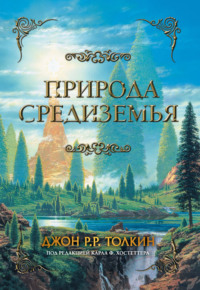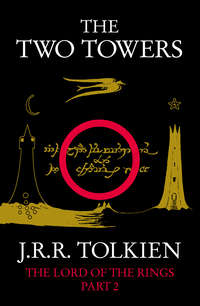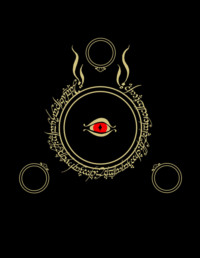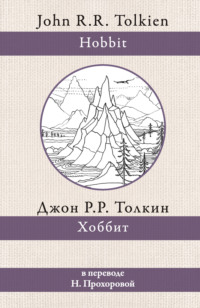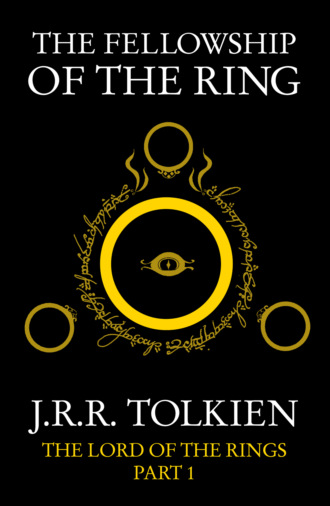
Полная версия
The Fellowship of the Ring



THE FELLOWSHIP OF THE RING
BEING THE FIRST PART OF
THE LORD OF THE RINGS
BY
J.R.R. TOLKIEN



COPYRIGHT
HarperCollins Publishers
1 London Bridge Street
London SE1 9GF
www.tolkien.co.uk
www.tolkienestate.com

Published by HarperCollins Publishers 2008
This edition is based on the reset edition first published 2004
First published in Great Britain by George Allen & Unwin 1954
Second Edition 1966
Copyright © The Trustees of the J.R.R.Tolkien 1967 Settlement 1954, 1966
All rights reserved under International and Pan-American Copyright Conventions. By payment of the required fees, you have been granted the non-exclusive, non-transferable right to access and read the text of this e-book on-screen. No part of this text may be reproduced, transmitted, down-loaded, decompiled, reverse engineered, or stored in or introduced into any information storage and retrieval system, in any form or by any means, whether electronic or mechanical, now known or hereinafter invented, without the express written permission of HarperCollins e-books.
HarperCollinsPublishers has made every reasonable effort to ensure that any picture content and written content in this ebook has been included or removed in accordance with the contractual and technological constraints in operation at the time of publication.
Source ISBN: 9780261102927
Ebook Edition MARCH 2009 ISBN: 9780007322497
Version: 2018-03-02
Three Rings for the Elven-kings under the sky,
Seven for the Dwarf-lords in their halls of stone,
Nine for Mortal Men doomed to die,
One for the Dark Lord on his dark throne
In the Land of Mordor where the Shadows lie.
One Ring to rule them all, One Ring to find them,
One Ring to bring them all and in the darkness bind them
In the Land of Mordor where the Shadows lie.
CONTENTS
COVER PAGE
TITLE PAGE
COPYRIGHT
NOTE ON THE TEXT
NOTE ON THE 50TH ANNIVERSARY EDITION
FOREWORD TO THE SECOND EDITION
PROLOGUE
BOOK ONE
CHAPTER 1: A LONG-EXPECTED PARTY
CHAPTER 2: THE SHADOW OF THE PAST
CHAPTER 3: THREE IS COMPANY
CHAPTER 4: A SHORT CUT TO MUSHROOMS
CHAPTER 5: A CONSPIRACY UNMASKED
CHAPTER 6: THE OLD FOREST
CHAPTER 7: IN THE HOUSE OF TOM BOMBADIL
CHAPTER 8: FOG ON THE BARROW-DOWNS
CHAPTER 9: AT THE SIGN OF THE PRANCING PONY
CHAPTER 10: STRIDER
CHAPTER 11: A KNIFE IN THE DARK
CHAPTER 12: FLIGHT TO THE FORD
BOOK TWO
CHAPTER 1: MANY MEETINGS
CHAPTER 2: THE COUNCIL OF ELROND
CHAPTER 3: THE RING GOES SOUTH
CHAPTER 4: A JOURNEY IN THE DARK
CHAPTER 5: THE BRIDGE OF KHAZAD-DÛM
CHAPTER 6: LOTHLÓRIEN
CHAPTER 7: THE MIRROR OF GALADRIEL
CHAPTER 8: FAREWELL TO LÓRIEN
CHAPTER 9: THE GREAT RIVER
CHAPTER 10: THE BREAKING OF THE FELLOWSHIP
MAPS
KEEP READING
WORKS BY J.R.R. TOLKIEN
ABOUT THE PUBLISHER
NOTE ON THE TEXT
J.R.R. Tolkien’s The Lord of the Rings is often erroneously called a trilogy, when it is in fact a single novel, consisting of six books plus appendices, sometimes published in three volumes.
The first volume, The Fellowship of the Ring, was published in Great Britain by the London firm George Allen & Unwin on 29 July 1954; an American edition followed on 21 October of the same year, published by Houghton Mifflin Company of Boston. In the production of this first volume, Tolkien experienced what became for him a continual problem: printer’s errors and compositor’s mistakes, including well-intentioned ‘corrections’ of his sometimes idiosyncratic usage. These ‘corrections’ include the altering of dwarves to dwarfs, elvish to elfish, further to farther, nasturtians to nasturtiums, try and say to try to say and (‘worst of all’ to Tolkien) elven to elfin. In a work such as The Lord of the Rings, containing invented languages and delicately constructed nomenclatures, errors and inconsistencies impede both the understanding and the appreciation of serious readers – and Tolkien had many such readers from very early on. Even before the publication of the third volume, which contained much hitherto unrevealed information on the invented languages and writing systems, Tolkien received many letters from readers written in these systems, in addition to numerous enquiries on the finer points of their usage.
The second volume, The Two Towers, was published in England on 11 November 1954 and in the United States on 21 April 1955. Meanwhile Tolkien worked to keep a promise he had made in the foreword to volume one: that ‘an index of names and strange words’ would appear in the third volume. As originally planned, this index would contain much etymological information on the languages, particularly on the elven tongues, with a large vocabulary. It proved the chief cause of the delay in publishing volume three, which in the end contained no index at all, only an apology from the publisher for its absence. For Tolkien had abandoned work on it after indexing volumes one and two, believing its size and therefore its cost to be ruinous.
Volume three, The Return of the King, finally appeared in England on 20 October 1955 and in the United States on 5 January 1956. With the appearance of the third volume, The Lord of the Rings was published in its entirety, and its first edition text remained virtually unchanged for a decade. Tolkien had made a few small corrections, but further errors entered The Fellowship of the Ring in its December 1954 second impression when the printer, having distributed the type after the first printing, reset the book without informing the author or publisher. These include misrepresentations of the original printed text – that is, words and phrases that read acceptably in context, but which depart from Tolkien’s wording as originally written and published.
In 1965, stemming from what then appeared to be copyright problems in the United States, an American paperback firm published an unauthorized and non-royalty-paying edition of The Lord of the Rings. For this new edition by Ace Books the text of the narrative was reset, thus introducing new typographical errors; the appendices, however, were reproduced photographically from the hardcover edition, and remain consistent with it.
Tolkien set to work on his first revision of the text so that a newly revised and authorized edition could successfully compete on the American market. This first revision of the text was published in America in paperback by Ballantine Books, under licence from Houghton Mifflin, in October 1965. In addition to revisions within the text itself, Tolkien replaced his original foreword with a new one. He was pleased to remove the original foreword; in his check copy, he wrote of it: ‘confusing (as it does) real personal matters with the “machinery” of the Tale, is a serious mistake’. Tolkien also added an extension to the prologue and an index – not the detailed index of names promised in the first edition, but, rather, a bald index with only names and page references. Additionally, at this time the appendices were greatly revised.
Tolkien received his copies of the Ballantine edition in late January 1966, and in early February he recorded in his diary that he had ‘worked for some hours on the Appendices in Ballantine version & found more errors than I at first expected’. Soon after this he sent a small number of further revisions to Ballantine for the appendices, including the now well-known addition of ‘Estella Bolger’ as wife of Meriadoc in the family trees in Appendix C. Most of these revisions, which entered variously in the third and fourth impressions ( June and August 1966) of volume three, and which were not always inserted correctly (thereby causing further confusion in the text), somehow never made it into the main sequence of revision in the three-volume British hardcover edition, and for long remained anomalies. Tolkien once wrote, concerning the revising of The Lord of the Rings, that perhaps he had failed to keep his notes in order; this errant branch of revision seems likely to be an example of that disorder – either in his notes or in the ability of his publishers to follow them with utmost accuracy.
The revised text first appeared in Great Britain in a three-volume hardcover ‘Second Edition’ from Allen & Unwin on 27 October 1966. But again there were problems. Although the revisions Tolkien sent to America of the text itself were available to be utilized in the new British edition, his extensive revisions to the appendices were lost after being entered into the Ballantine edition. Allen & Unwin were forced to reset the appendices using the copy as published in the first Ballantine edition. This did not include Tolkien’s second, small set of revisions sent to Ballantine; but, more significantly, it did include a great number of errors and omissions, many of which were not discovered until long afterwards. Thus, in the appendices, a close scrutiny of the first edition text and of the much later corrected impressions of the second edition is necessary to discern whether any particular change in this edition is authorial or erroneous.
In America, the revised text appeared in hardcover in the three-volume edition published by Houghton Mifflin on 27 February 1967. This text was evidently photo-offset from the 1966 Allen & Unwin three-volume hardcover, and is thus consistent with it. Aside from the first printing of this second Houghton Mifflin edition, which has a 1967 date on the title page, none of the many reprintings is dated. After the initial printings of this edition, which bore a 1966 copyright notice, the date of copyright was changed in 1965 to match the statement in the Ballantine edition. This change has caused a great deal of confusion for librarians and other researchers who have tried to sort out the sequence of publication of these editions.
Meanwhile, Tolkien spent much of the summer of 1966 further revising the text. In June he learned that any more revisions were too late for inclusion in the 1966 Allen & Unwin second edition, and he recorded in his diary: ‘But I am attempting to complete my work [on the revisions] – I cannot leave it while it is all in my mind. So much time has been wasted in all my work by this constant breaking of threads.’ This was the last major set of revisions Tolkien himself made to the text during his lifetime. They were added to the second impression (1967) of the three-volume hard-cover Allen & Unwin second edition. The revisions themselves mostly include corrections of nomenclature and attempts at consistency of usage throughout the three volumes. Some small alterations were made by Tolkien in the 1969 one-volume India paper edition.
J.R.R. Tolkien died in 1973. His third son and literary executor, Christopher Tolkien, sent a large number of further corrections of misprints, mainly in the appendices and index, to Allen & Unwin for use in their editions in 1974. Most of these corrections were typographical, and in line with his father’s expressed intent in his own check copies.
Since 1974, Christopher Tolkien has sent additional corrections, as errors have been discovered, to the British publishers of The Lord of the Rings (Allen & Unwin, later Unwin Hyman, and now HarperCollins), who have tried to be conscientious in the impossible task of maintaining a textual integrity in whichever editions of The Lord of the Rings they have published. However, every time the text has been reset for publication in a new format (e.g. the various paperback editions published in England in the 1970s and 1980s), huge numbers of new misprints have crept in, though at times some of these errors have been observed and corrected in later printings. Still, throughout these years the three-volume British hardcover edition has retained the highest textual integrity.
In the United States, the text of the Ballantine paperback has remained unchanged for more than three decades after Tolkien added his few revisions in 1966. The text in all of the Houghton Mifflin editions remained unchanged from 1967 until 1987, when Houghton Mifflin photo-offset the then current three-volume British hardcover edition in order to update the text used in their editions. In those new reprintings a number of further corrections (overseen by Christopher Tolkien) were added, and the errant Ballantine branch of revision (including the ‘Estella Bolger’ addition) was integrated into the main branch of textual descent. This method of correction involved a cut-and-paste process with printed versions of the text. Beginning with the 1987 Houghton Mifflin edition, an earlier version of this ‘Note on the Text’ (dated October 1986) was added to The Lord of the Rings. This ‘Note’ has been reworked three times since then – the version dated April 1993 first appeared in 1994, and the version dated April 2002 came out later that year. The present ‘Note’ replaces and supersedes all previous versions.
For the 1994 British edition published by HarperCollins, the text of The Lord of the Rings was entered into word-processing files. This next stage of textual evolution came about to allow for a greater uniformity of the text in all future editions, but with it, inevitably, came new wrinkles. Some new misreadings entered into the text, while at the same time others were fixed. In the worst instance, one line of the ring inscription in the chapter ‘The Shadow of the Past’ of The Fellowship of the Ring was simply dropped. Unforeseeable glitches arose in other editions when the base computerized text was transferred into page-making or typesetting programs – e.g., in one edition of The Fellowship of the Ring, the closing two sentences of ‘The Council of Elrond’ simply and inexplicably disappeared. Such glitches have been very much the exception, not the rule, and the text has otherwise maintained a consistency and integrity throughout its computerized evolution.
The 1994 edition also contained a number of new corrections (again supervised by Christopher Tolkien), as well as a reconfigured index of names and page references. The 1994 text was first used in American editions published by Houghton Mifflin in 1999. A small number of further corrections were added into the 2002 three-volume edition illustrated by Alan Lee, published by HarperCollins in Great Britain and Houghton Mifflin in the United States.
The textual history of The Lord of the Rings, merely in its published form, is a vast and complex web. In this brief note I have given only a glimpse of the overall sequence and structure. Further details on the revisions and corrections made over the years to the published text of The Lord of the Rings, and a fuller account of its publishing history, may be found in J.R.R. Tolkien: A Descriptive Bibliography, by Wayne G. Hammond, with the assistance of Douglas A. Anderson (1993).
For those interested in observing the gradual evolving of The Lord of the Rings from its earliest drafts to its published form, I highly recommend Christopher Tolkien’s account, which appears within five volumes of his twelve-volume series The History of Middle-earth. Volumes six through nine contain the major part of his study pertaining to The Lord of the Rings: The Return of the Shadow (1988); The Treason ofIsengard (1989); The War of the Ring (1990); and Sauron Defeated (1992). Also, the final book of the series, The Peoples of Middle-earth (1996), covers the evolution of the prologue and appendices to The Lord of the Rings. These volumes contain an engrossing over-the-shoulder account of the growth and writing of Tolkien’s masterpiece.
The process of studying Tolkien’s manuscripts of The Lord of the Rings involved the deciphering of versions where Tolkien wrote first in pencil and then in ink atop the pencilled draft. Christopher Tolkien has described his father’s method of composition in The Return of the Shadow: ‘In the handwriting that he used for rapid drafts and sketches, not intended to endure long before he turned to them again and gave them a more workable form, letters are so loosely formed that a word which cannot be deduced or guessed at from the context or from later versions can prove perfectly opaque after long examination; and if, as he often did, he used a soft pencil much has now become blurred and faint.’ The true difficulty of reading such double-drafts can be observed in the frontispiece to The War of the Ring, which reproduces in colour Tolkien’s illustration of ‘Shelob’s Lair’ from a page of Tolkien’s manuscript. Looking very closely at the hasty ink draft alongside the illustration, one can see underneath it the earlier, hastier, pencilled draft. Also in The War of the Ring, Christopher Tolkien reproduces a page from the first manuscript of the chapter ‘The Taming of Sméagol’, and the printed text corresponding to this text is on the facing page (see pp. 90–91). One is astonished at anyone’s ability to decipher such texts.
That difficulty aside, just what do these books signify to ordinary readers and to Tolkien scholars? And what is ‘the history of the writing’ of a book? Simply, these volumes show in great detail the development of the story of The Lord of the Rings from its very earliest drafts and hasty projections through its completion. We see in the earliest materials what is very much a children’s book, a sequel to The Hobbit, and as the story grows through various ‘phases’, there is an increase in seriousness and depth. We see alternate branches of development, the gradual blending and merging of certain characters, and the slow emergence of the nature of the rings and of the motivations of other characters. Some of these various ideas are abandoned altogether, while others are reworked into some variant form that may or may not survive into the final version.
One could make a whole catalogue of interesting tidbits from Christopher Tolkien’s study – such as the fact that Strider was called Trotter until a very late stage in the writing of the book; that Trotter was at one time a hobbit, so named because he wore wooden shoes; that Tolkien at one point considered a romance between Aragorn and Éowyn; that Tolkien wrote an epilogue to the book, tying up loose ends, but it was dropped before publication (and now appears in Sauron Defeated); and so on. But these developments are best appreciated when read within the context of Christopher Tolkien’s commentary rather than discussed separately.
The most significant achievement of these volumes is that they show us how Tolkien wrote and thought. Nowhere else do we see the authorial process itself at work in such detail. Tolkien’s hastiest comments about where the story might proceed, or why it can or can’t go such and such a way – these queries to himself were written out: Tolkien is literally thinking on paper. This gives an added dimension of understanding to Tolkien’s comment to Stanley Unwin in a 1963 letter that, when suffering from trouble with his shoulder and right arm, ‘I found not being able to use a pen or pencil as defeating as the loss of her beak would be to a hen.’ And we, as readers of these volumes, can share with Tolkien himself the wonder and bewilderment of new characters appearing as if from nowhere, or of some other sudden change or development, at the very moment of their emergence into the story.
I know of no other instance in literature where we have such a ‘history of the writing’ of a book, told mostly by the author himself, with all the hesitations and false paths laid out before us, sorted out, commented upon, and served up to a reader like a feast. We are shown innumerable instances in the minutest detail of the thought-process itself at work. We see the author fully absorbed in creation for its own sake. And this is all the more exceptional because this is a history not only of the unfolding of a story and its text, but of the evolution of a world. There is an additional wealth of material beyond simple narrative text. There are maps and illustrations. There are languages and writing systems, and the histories of the peoples who spoke and wrote in these systems. All of these additional materials add multiple dimensions of complexity to our appreciation of the invented world itself.
Fifty years into the published life of The Lord of the Rings, it seems extraordinary to me that we have not only such a masterful work of literature but also as a companion to it an unparalleled account of its writing. Our gratitude as readers goes to both of the Tolkiens, father and son.
Douglas A. Anderson
May 2004
NOTE ON THE 50TH ANNIVERSARY EDITION
In this edition of The Lord of the Rings, prepared for the fiftieth anniversary of its publication, between three and four hundred emendations have been made following an exhaustive review of past editions and printings. The present text is based on the setting of the HarperCollins three-volume hardcover edition of 2002, which in turn was a revision of the HarperCollins reset edition of 1994. As Douglas A. Anderson comments in the preceding ‘Note on the Text’, each of those editions was itself corrected, and each also introduced new errors. At the same time, other errors survived undetected, among them some five dozen which entered as long ago as 1954, in the resetting of The Fellowship of the Ring published as its ‘second impression’.
That the printer had quietly reset The Fellowship of the Ring, and that copies had been issued without proof having been read by the author, never became known to Tolkien; while his publisher, Rayner Unwin, learned of it only thirty-eight years after the fact. Tolkien found a few of the unauthorized changes introduced in the second printing when (probably while preparing the second edition in 1965) he read a copy of the twelfth impression (1962), but thought the errors newly made. These, among others, were corrected in the course of the reprinting. Then in 1992 Eric Thompson, a reader with a keen eye for typographic detail, noticed small differences between the first and second impressions of The Fellowship of the Ring and called them to the attention of the present editors. About one-sixth of the errors that entered in the second printing quickly came to light. Many more were revealed only recently, when Steven M. Frisby used ingenious optical aids to make a comparison of copies of The Lord of the Rings in greater detail than was previously accomplished. We have gladly made full use of Mr Frisby’s results, which he has generously shared and discussed.


